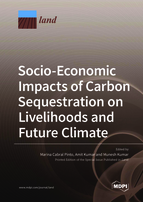Socio-Economic Impacts of Carbon Sequestration on Livelihoods and Future Climate
A special issue of Land (ISSN 2073-445X).
Deadline for manuscript submissions: closed (30 September 2021) | Viewed by 37801
Special Issue Editors
Interests: environmental geochemistry; medical mineralogy; medical geology; international geochemical mapping; water quality; soil quality; dust quality; health risk assessment; heavy metals; potentially toxic elements; epidemiology; neurosciences
Special Issues, Collections and Topics in MDPI journals
Interests: biogeochemistry; environmental impact assessment; environment; eco-hydrology; carbon sequestration; soil analysis; soil chemistry; GHG emission; climate change; water quality; rivers
Special Issues, Collections and Topics in MDPI journals
Interests: soils, exposure and helth; carbon sequestration
Special Issues, Collections and Topics in MDPI journals
Special Issue Information
Dear colleagues,
In the modern era, carbon sequestration represents a long-lasting solution for the mitigation and management of CO2 emissions. However, claims of net carbon reduction and its impact on socioeconomic development are, as yet, unverified and comprise hotspots for present research. Socioeconomic factors, such as population, economic growth, demography, land use changes, lifestyle changes, and environmental policies, are the key driving forces underlying medium- to long-term greenhouse gas (GHG) emissions. These influencing factors pose a challenge with regard to their mitigation and imply further costs toward meeting a stringent climate goal like the 1.5 °C climate target.
The concentration of atmospheric CO2 has accelerated upward during the last few decades at an annual rate of 1.91 ppm due to various anthropogenic activities, leading to an increase in atmospheric CO2 concentration from 317 ppm in 1958 to 413 ppm in 2020. Forests are important for the global carbon cycle because they sequester carbon from the atmosphere while also emitting carbon, resulting in the loss of biomass. Precise information on forest carbon stocks is important in understanding the offsetting capabilities of forests. The precise estimation of forest carbon is also required for understanding the role of the forest in mitigating actions as well as to evaluate the role of forests through their ecosystem services. Forest carbon estimates are also required to evaluate forest degradation since anthropogenic extractions from forests result in the degradation of forests. By contrast, precise estimates of carbon in specific forests are largely not available due to the lack of resources and experts across the globe.
Agricultural practices promoting “soil health” are argued as being effective for soil carbon sequestration, while soil scientists and environmentalists broadly dismiss their likelihood of success in proving net carbon reductions of GHGs in the atmosphere. Moreover, they also have the potential to safeguard human health from climate change impacts. The literature reveals that very little study has been carried out on carbon sequestration and its medium-/long-term impact on socioeconomic management. Although filling these gaps in research is vital for sustainable environmental management, state-of-the-art studies combining soil sciences and changing land use and land cover (LULC) patterns and their impact on socioeconomics are missing.
This Special Issue explores soil carbon sequestration, the impact of deforestation on climate change, vulnerability risk for climate and ecological life, socioeconomic impacts, and strategies for the mitigation of future climatic impacts. The theme of the Special Issue extends across terrestrial ecosystems, environmental policy domains (e.g., REDD+ and the Paris Agreement), environmental applications (e.g., urbanization, agroforestry, and intensive LULC changes), and carbon credit generated worldwide (both voluntary and through compliance). This Special Issue is highly useful for environmentalists, water resource planners and managers, and policymakers in understanding the potential of carbon sequestration on a regional and global scale and, further, the medium-/long-term impacts on socioeconomic development resulting from its implementation via climate change modeling.
Dr. Marina Cabral Pinto
Dr. Amit Kumar
Dr. Munesh Kumar
Guest Editors
Manuscript Submission Information
Manuscripts should be submitted online at www.mdpi.com by registering and logging in to this website. Once you are registered, click here to go to the submission form. Manuscripts can be submitted until the deadline. All submissions that pass pre-check are peer-reviewed. Accepted papers will be published continuously in the journal (as soon as accepted) and will be listed together on the special issue website. Research articles, review articles as well as short communications are invited. For planned papers, a title and short abstract (about 100 words) can be sent to the Editorial Office for announcement on this website.
Submitted manuscripts should not have been published previously, nor be under consideration for publication elsewhere (except conference proceedings papers). All manuscripts are thoroughly refereed through a single-blind peer-review process. A guide for authors and other relevant information for submission of manuscripts is available on the Instructions for Authors page. Land is an international peer-reviewed open access monthly journal published by MDPI.
Please visit the Instructions for Authors page before submitting a manuscript. The Article Processing Charge (APC) for publication in this open access journal is 2600 CHF (Swiss Francs). Submitted papers should be well formatted and use good English. Authors may use MDPI's English editing service prior to publication or during author revisions.
Keywords
- land use and land cover
- soil
- health risk
- environmental chemistry
- biogeochemical
- ecological health
- carbon sequestration
- vulnerability assessment
- carbon stock
- forestry








